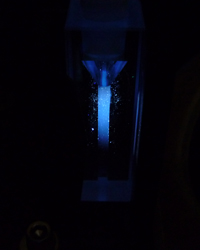Researchers from the Department of Physics and Astronomy at the University of Leicester have developed a new synthetic method that leads to the creation of new radioactive zorn nanoparticles that may help monitor the activity and discharge of drugs in the body's cells

Researchers from the Department of Physics and Astronomy at the University of Leicester have developed a new synthetic method that leads to the creation of new radioactive zorn nanoparticles that may help monitor the activity and discharge of drugs in the body's cells.
The researcher Dr. Klaus von Haeften explains: "A key advantage of the modern method is the independent control of the size of the nanoparticles and their surface properties. The method is extremely versatile and produces radiating suspensions instantly. The findings may revolutionize the performance of electronic chips while meeting the ever-increasing demand for greater and greater capacity."
The nanoparticles consist of hundreds of silicon atoms and their fluorescence was discovered after mixing them with water. As a result, a stable radiation intensity was obtained for more than three months.
An interdisciplinary research project with the Department of Chemistry also utilizes this state-of-the-art preparation method to attach radioactive nanoparticles to drugs for the purpose of monitoring, diagnosing and treating cancer.
One of the researchers says: "Nanotechnology - the use of structures whose dimensions are on a nanometer scale to prepare new materials and devices - is a key component in future scientific developments in a variety of fields of technology, including materials, sciences, health and information."
Another researcher adds and says: "The approach developed at the university could be a key step towards the development of diverse biomedical sensors that could help monitor the activity of drugs in cells."
The harmless nature of the form makes the nanoparticles useful as radioactive markers for marking and labeling sensitive biological substances. The radiation emitted from a single nanoparticle is relatively easily detectable.
The findings of this study were published this month in the scientific journal Applied Physics Letters.
